ISBAD 2022: Challenges and Barriers in Accessing Effective Snakebite Treatment
Terrain and physical land obstacles. Lack of basic transportation. Unequipped primary health centers devoid of trained health workers. Time lost seeking traditional medicine options. Communities lacking education on preventing snakebites and the proper first aid to practice in the event of a bite.
All of these are challenges and barriers to accessing effective treatment for a snake bite in all parts of the world.
The theme of this year’s International Snakebite Awareness Day, which took place on Monday 19 September, was on ‘Challenges and Barriers in Accessing Effective Snakebite Treatment’.
We spoke to some of our Early Career Grant (previously know as Small Grant) awardees and asked for their contribution to the theme, as well as to tell us why they chose to do research into snakebite.
Dr Syafiq Asnawi Zainal Abidin
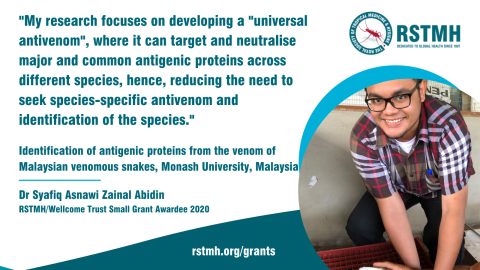
Research topic: Identification of antigenic proteins from the venom of Malaysian venomous snakes, Monash University, Malaysia
Why did you choose to do research in snakebite?
My earliest work with snake venom involved identifying and characterising proteins with anticancer potential. Since the WHO announced snakebite envenoming as the highest priority neglected tropical disease, I have decided to utilise my expertise and research experience to help improve the envenomation situation in my country (Malaysia) and South East Asia.
What Challenges and Barriers in Accessing Effective Snakebite Treatment have you seen?
My research focuses on developing a "universal antivenom", where it can target and neutralise major and common antigenic proteins across different species, hence, reducing the need to seek species-specific antivenom and identification of the species.
Wellcome Trust/RSTMH Small Grant awardee 2020
Cecilie Knudsen
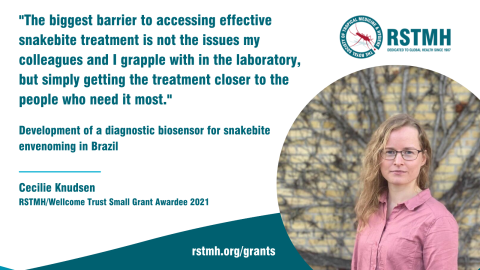
Research topic: Development of a diagnostic biosensor for snakebite envenoming in Brazil
Why did you choose to do research in snakebite?
I believe that snakebite diagnostics have the potential to help a lot of people. They could help bring treatment closer to snakebite victims by empowering people at remote locations to more confidently determine what type of antivenom to administer, thereby supporting efforts to decentralise antivenoms in the Brazilian Amazon. They could also help ensure that sparse antivenoms are not wasted on bites caused by nonvenomous snakes or on bites for which they are not indicated. Finally, they could aid healthcare providers in deciding which antivenoms to procure and where to deploy them as well as inform the design of future antivenoms.
What Challenges and Barriers in Accessing Effective Snakebite Treatment have you seen?
During a research stay at a hospital in Manaus, I had a conversation with a snakebite victim that made a big impression on me. The man described how he had been bitten by a snake and how a friend had treated the bite wound with traditional medicine before they had left for the hospital.
The traditional medicine (a sort of paste made from meat from the biting snake and applied to the bite site) had caused an infection, which was now being treated in addition to the envenoming. Another person in the room asked the snakebite victim if he would use traditional medicine in the future if he were to ever be bitten again, and to my surprise, he said “yes, because I live very far from the hospital, and it’s the only remedy we have”.
To me, this drove home the point that sometimes the biggest barrier to accessing effective snakebite treatment is not the issues my colleagues and I grapple with in the laboratory, but simply getting the treatment closer to the people who need it most.
Wellcome Trust/RSTMH Small Grant awardee 2021
Elvis Nekehforba
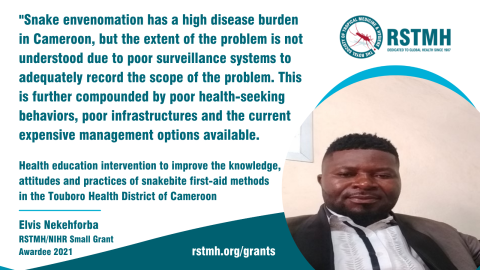
Research topic: Health education intervention to improve the knowledge, attitudes and practices of snakebite first-aid methods in the Touboro Health District of Cameroon
Why did you choose to do research in snakebite?
Cameroon is one of five African countries described as ‘snake pockets’ characterized by annual snakebite incidence of over 400 per 100,000 populations. The North Region of Cameroon has the highest reported burden of snakebite in the country, with an annual envenoming rate of 200 to 300 per 100,000 population, depending on the locality, with a high case fatality rate of up to 23% reported in the Touboro Health District in the past 4 years .Snake envenomation has a high disease burden in Cameroon, but the extent of the problem is not understood due to poor surveillance systems to adequately record the scope of the problem. This is further compounded by poor health-seeking behaviors, poor infrastructures and the current expensive management options available.
What Challenges and Barriers in Accessing Effective Snakebite Treatment have you seen?
In our current research, we had a total of 427 participants in our baseline data. Majority 352(82.4%) were farmers. This posed a serious challenge and a barrier to effective snakebite treatment. This is because most of these snakes are found in bushes were these farmers cultivate their crops, coupled with the distances of the farms from homes and health facilities, culminating to a delay of victims in reaching the health facilities on time.
Another big challenge is the poor knowledge of the population of Touboro on snakebite treatment as majority 343(80.3%) believed that the victim of snakebite should always be given traditional medicine to eat or drink. Moreover a greater proportion 351(82.2%) noted that cutting an incision on the bite site is good to let out poisonous blood. This eventually delays the transportation of the victim to the health services for effective treatment.
NIHR/RSTMH Small Grant awardee 2021
Dr Michelle Yap Khai Khun
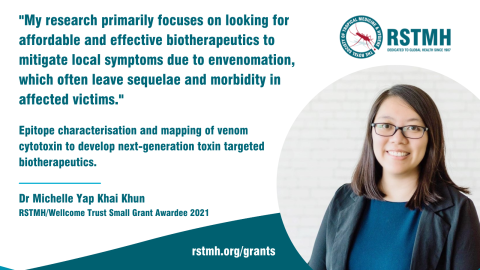
Research topic: Epitope characterisation and mapping of venom cytotoxin to develop next-generation toxin targeted biotherapeutics.
Why did you choose to do research in snakebite?
Why do I choose to pursue research in the snakebite area? As a toxinologist, I have always been very excited to study venom toxins, which are diverse and fascinating. My interests focus on toxins which cause irreversible local envenomation. I study the immunological properties of venom toxins using a combination of mass-spectrometry and computational approaches. The ultimate goal is to develop an enriched tool for next-generation biotherapeutics for snakebites.
What Challenges and Barriers in Accessing Effective Snakebite Treatment have you seen?
My research primarily focuses on looking for affordable and effective biotherapeutics to mitigate local symptoms due to envenomation, which often leave sequelae and morbidity in affected victims. The roadblocks in accessing effective therapies motivate and inspire me to stay focused in this area, and I hope my research can one day provide a solution to relieve the suffering of snakebite victims.
Wellcome Trust/RSTMH Small Grant awardee 2021
Dr Susan Kizito
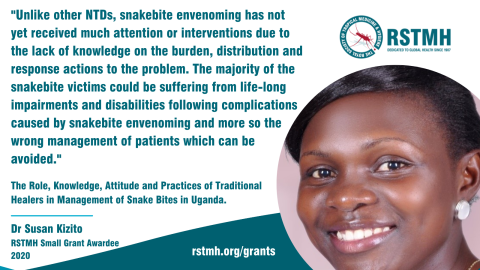
Research topic: The Role, Knowledge, Attitude and Practices of Traditional Healers in Management of Snake Bites in Uganda
Why did you choose to do research in snakebite?
Snakebite envenoming is a new case-managed neglected tropical disease which is very common in the tropical countries like Uganda. Unlike other NTDs, snakebite envenoming has not yet received much attention or interventions due to the lack of knowledge on the burden, distribution and response actions to the problem. The majority of the snakebite victims could be suffering from life-long impairments and disabilities following complications caused by snakebite envenoming and more so the wrong management of patients which can be avoided. As an epidemiologist and researcher, my role is to provide scientific evidence that will support, public health implementers, policy makers and other technical officers to respond to this public health problem.
What Challenges and Barriers in Accessing Effective Snakebite Treatment have you seen?
I conducted a study on the roles, knowledge, attitude and practice of traditional healers in the management of snakebites in Uganda with the intention to find out how traditional healers have been contributing to the control and management of snakebites in the community. Study findings showed that traditional healers are a reference point and provide a baseline for snakebite management but their level of knowledge and practices while providing first aid management to snakebite victims is risky and sub-optimal.
We still have a long way to go in equipping traditional healers with the right skills and knowledge as well as creating community awareness on the harmful practices following snakebites. This can be enhanced through creating target-specific awareness campaigns and we need to involve traditional healers as key stakeholders in this awareness campaign.
RSTMH Small Grant awardee 2020
Joan Tusabe
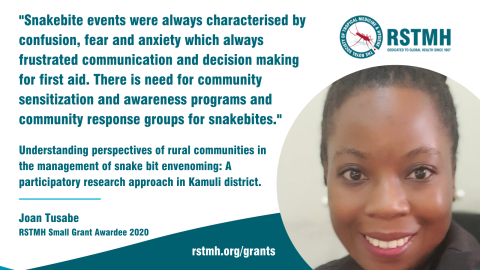
Research topic: Understanding perspectives of rural communities in the management of snake bit envenoming: A participatory research approach in Kamuli district.
Why did you choose to do research in snakebite?
Snakebites remain one of the neglected tropical diseases in Uganda. Rural areas are highly affected especially during the rainy season amidst challenges in accessing health care. Households mainly rely on traditional remedies for management of snakebites, which are not effective always and can lead to disability and sometimes death. We explored and learnt from the knowledge, perspectives, and healthcare seeking practices related to snake bites in Kamuli Eastern Uganda using the participatory research appraisal approach.
We found both individual/community specific and health system challenges to access and proper management of snakebite victims. Community challenges included; lack of knowledge about treatment remedies, poor communication among community members, and poverty. Health system challenges included: lack of antivenoms, means of emergency transport, poor road network, poor attitudes of health workers, and high cost of care.
What Challenges and Barriers in Accessing Effective Snakebite Treatment have you seen?
There is general lack of knowledge on first aid care, and treatment of snakebite victims. There were no community sensitization and awareness campaigns targeting snakebites even when contradictions in approaches for management of snakebites existed. Snakebite events were always characterised by confusion, fear and anxiety which always frustrated communication and decision making for first aid. Limited finances for both traditional and biomedical treatment as well as transport frustrated community members whose household incomes were low. They consequently had to incur out of pocket expenses hence pushing them further in poorer state than they were. There is need for community sensitization and awareness programs and community response groups for snakebites.
From the health systems’ perspective, it was often hard for victims to reach the health facilities because of lack of an emergency modes of transport after receiving first aid. This was worsened by the long distances to the health facilities and the poor road network connecting to them. Even when the victims of snakebites made it to the health facilities, antivenoms were often not available; and would require one to spend out of pocket access treatment in private health facilities. Additionally, there is low capacity to manage snake bites explained by no guidelines on snakebite management, lack of/inadequate snake bite treatments such as antivenoms and steroids, and limited number of staff skilled in snakebite management. Advocating for provision of antivenoms and other emergency treatment remedies in the health facilities, emergency means of transport in form of motorcycles and motor vehicles is vital in snake bite management.
Some of the participants’ quotations from our work below:
“The health centres are far away, so if the snake has bitten you from the swamp, you have to move from the swamp to home, then from home to a health facility. Sometimes, even transport may not be available; you might be using a bicycle to [nearby trading center] where there are reasonable health facilities…” (Male 28 years)
“…what stops people from going there [health facility], is just because they know even if they go they won’t find snakebite treatment.” (Male 42 years)
Wellcome Trust/RSTMH Small Grant awardee 2020
Nanyonga Stella Maris
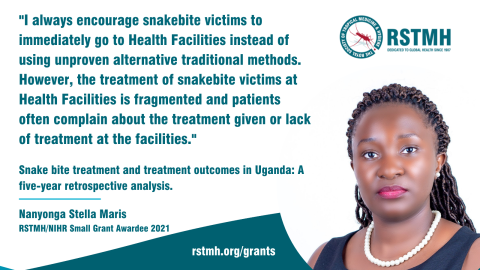
Research topic: Snake bite treatment and treatment outcomes in Uganda: A five-year retrospective analysis.
Why did you choose to do research in snakebite?
My area of expertise is patient care and I always encourage snakebite victims to immediately go to Health Facilities instead of using unproven alternative traditional methods. However, the treatment of snakebite victims at Health Facilities is fragmented and patients often complain about the treatment given or lack of treatment at the facilities. There is no documentation of the actual treatment given to snakebite cases at these facilities and yet we encourage the victims to go there. This inspired me to document the actual treatment that snakebite victims receive at Health Facilities in Uganda to identify best practices for scaling up and also document areas of improvement to inform quality improvement interventions in snakebite management.
What Challenges and Barriers in Accessing Effective Snakebite Treatment have you seen?
There is care fragmentation among snakebite victims at Health Facilities with different healthcare providers managing snakebite victims differently and not in line with best practices.
NIHR/RSTMH Small Grant awardee 2021
Scott Matafwali
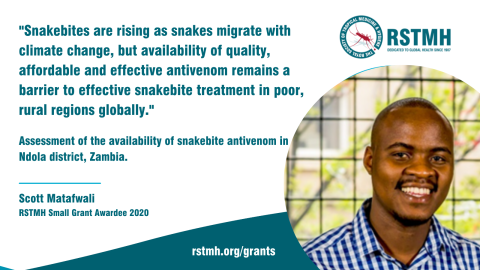
Research topic: Assessment of the availability of snakebite antivenom in Ndola district, Zambia.
Why did you choose to do research in snakebite?
Despite the high number of notified snakebites leading to disabilities and death, access to lifesaving antivenom is limited. I decided to investigate the availability of snakebite antivenom in hopes of providing baseline information which could be crucial to inform policy and contribute to understanding some barriers to access.
What Challenges and Barriers in Accessing Effective Snakebite Treatment have you seen?
Snakebites are rising as snakes migrate with climate change, but availability of quality, affordable and effective antivenom remains a barrier to effective snakebite treatment in poor, rural regions globally.
NIHR/RSTMH Small Grant awardee 2020
Dr Priyanka Kadam
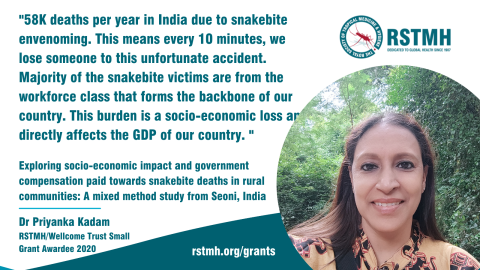
Research topic: Exploring socio-economic impact and government compensation paid towards snakebite deaths in rural communities: A mixed method study from Seoni, India.
Why did you choose to do research in snakebite?
58K deaths per year in India due to snakebite envenoming. This means every 10 minute, we lose someone to this unfortunate accident. Majority of the snakebite victims are from the workforce class that forms the backbone of our country. This burden is a socio-economic loss and directly affects the GDP of our country.
What Challenges and Barriers in Accessing Effective Snakebite Treatment have you seen?
Snakebite is treatable,
Life is priceless!
Countries need to step-up and
Improve access to healthcare at the Primary Health Centre level.
Such deaths can be avoided. MUST be avoided.
Wellcome Trust/RSTMH Small Grant awardee 2021
Dr Melisa Bernard
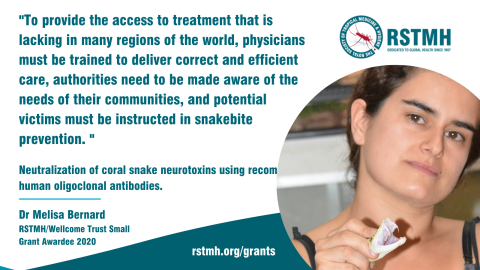
Research topic: Neutralization of coral snake neurotoxins using recombinant human oligoclonal antibodies.
Why did you choose to do research in snakebite?
I started working on snakebite because I am fascinated by venomous snakes and their toxins. But more importantly, the study of their venoms is a field that can lead to antivenom improvement and therefore great benefit for snakebite victims around the world. Also, understanding venomous snakes and their role in ecosystems can promote the conservation of these beautiful and misunderstood creatures.
What Challenges and Barriers in Accessing Effective Snakebite Treatment have you seen?
In the context of snakebite care, I believe education is the first problem that needs to be addressed. To provide the access to treatment that is lacking in many regions of the world, physicians must be trained to deliver correct and efficient care, authorities need to be made aware of the needs of their communities, and potential victims must be instructed in snakebite prevention.
Wellcome Trust/RSTMH Small Grant awardee 2020
Dr Peris Njoki Kung’u
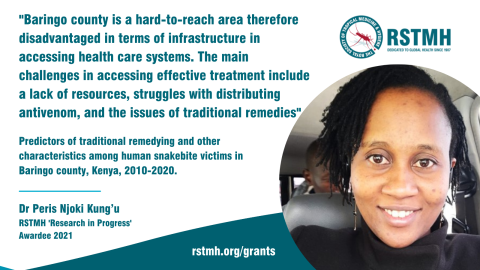
Reseach topic: Predictors of traditional remedying and other characteristics among human snakebite victims in Baringo county, Kenya, 2010-2020
Why did you choose to do research in snakebite?
My career interests predominantly deal with Public Health challenges, having worked across various disciplines including zoonotic diseases, one health programs and emergency preparedness and response. Snake bite is among the challenges affecting both humans and animals (snakes).
Snakebite is a neglected tropical disease which attributes to about 140,000 mortalities annually, worldwide. Not much research has been conducted, especially in Kenya (locally) hence little is known.
My research gathered data from snakebite victims, analysed and provided information to the wider community, including policy makers. I believe these deaths can be reduced by addressing the gaps and inadequacies in the health care systems in Kenya, through policy change and implementation.
What Challenges and Barriers in Accessing Effective Snakebite Treatment have you seen?
My research involved FGD with snakebite survivors from Marigat- Baringo County in Kenya. Baringo county is a hard-to-reach area therefore disadvantaged in terms of infrastructure in accessing health care systems. We discovered that among the main challenges in accessing effective treatment included:
Lack of resources
- Transport to the health facility
- Cost of treatment especially if you lack health insurance where most of the Marigat residents lacked
- Poorly equipped health facilities where they are not able to deal with snake bite emergencies effectively
Antivenom
- Expensive and require several administrations for effectiveness in most cases
- Adverse reaction to the victims as the antivenom is not specific to the local snake species
- Lack of local production of antivenom
Traditional remedying being preferred
- Easier access
- Less costly/cheaper than hospitals
- Socio-cultural beliefs
Marigat communities are mainly pastoralists therefore may move to very remote areas
Tribal conflict in Baringo county
NIHR/RSTMH Small Grant awardee 2020
Demise Mulugeta
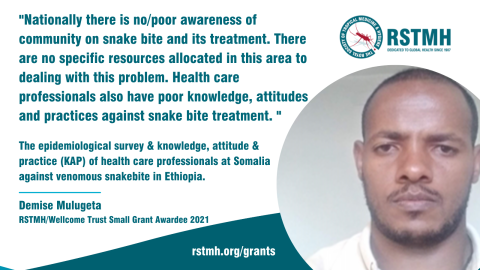
Research topic: The epidemiological survey & knowledge, attitude & practice (KAP) of health care professionals at Somalia against venomous snakebite in Ethiopia.
Why did you choose to do research in snakebite?
Snakebite envenoming is a neglected tropical disease (NTD) that is a major public health problem which affects mostly community live in rural area of the country. It causes high mortality and morbidity in people, mainly due to acute injury and permanent sequel, and has substantial financial consequences associated with its clinical management and wage losses due to absenteeism. It is often described as an occupational disease, particularly affecting farmers, cattle herders, and other agricultural workers in poor rural communities. Globally, mortality has been shown to be strongly correlated with the percentage of workforce in agriculture.
Most of Ethiopian population lives in rural area of the country which depends on agriculture and facing a high incidence of snakebites and low access to treatment. There are no specific resources allocated in this area to dealing with this problem. The number of snakebite victims arriving at health facilities is not recorded that making it impossible to know the national health burden of snakebites. Nationally there is no/poor awareness of community on snake bite and its treatment. Health care professional’s also have poor knowledge, attitudes and practice against snake bite treatment. These are all problems which initiated me to research on epidemiological and knowledge, attitudes and practice of health care professionals in selected regions of the country.
Wellcome Trust/RSTMH Small Grant awardee 2021
Dr Robert Rono
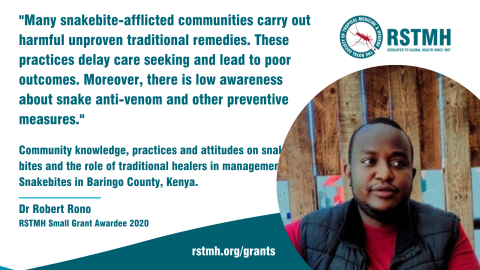
Research topic: Community knowledge, practices and attitudes on snake bites and the role of traditional healers in management of Snakebites in Baringo County, Kenya.
Why did you choose to do research in snakebite?
I chose to study snakebite envenoming after I observed a gap in understanding on the burden of snakebites in Baringo, County Kenya. Despite snakebite being a significant public health challenge, there is lack of community-based research to assess the knowledge attitudes and practices of communities which are endemic for snakebites. There is poor understanding of and minimal interaction between the health system and traditional snakebite healers. It is therefore necessary for me to study the role of traditional healers and understand why they are trusted by the community as the primary caregivers for most snakebite victims. It was also necessary to understand the prevention and therapeutic measures known to the communities so as to develop intervention measures. These include: development of public health education and awareness measures, household level interventions and clinical interventions. These will ensure that the global goal of reducing mortality and morbidity by 50% is achieved.
What Challenges and Barriers in Accessing Effective Snakebite Treatment have you seen?
Snakebite afflicted communities carry out harmful snakebite practices to snakebite victims. These include use of unproven traditional remedies such as “black stone”, consultation and treatment by traditional healers. This is in addition to other harmful first aid practices such as tying of tourniquet, making cuttings and applying traditional medicaments on snakebite wounds. These practices delay care seeking and lead to poor outcomes. Moreover, there is low awareness on use of snake anti-venom and other preventive measures. To mitigate this, community health workers should be trained on prevention and care of snakebite cases at household levels.
Wellcome Trust/RSTMH Small Grant awardee 2020
Dr Rita Salifu
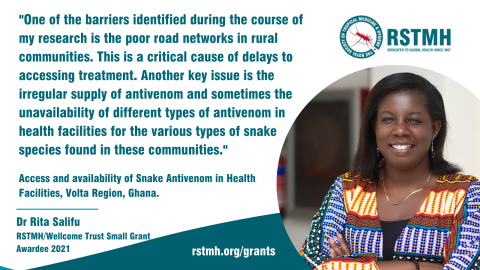
Research topic: Access and availability of Snake Antivenom in Health Facilities, Volta Region, Ghana
Why did you choose to do research in snakebite?
My initial exposure to the issues of snakebites and its consequential effects on not just the health and wellbeing of the victim, but also their livelihoods, began when people in my community shared their experiences of being bitten by one snake or another. Snake bites in my community is considered inevitable by the community folk. This belief may be due to the fact that most of them are farmers who regularly encounter snakes, hence have accepted that snake bites will occur at one point in the farming season or another. What was even more interesting was the remedy for the treatment of snakebites. It was linked to the herbalist who prepares concoctions which you apply to the bite area. There was also the chewing of particular herbs, drinking of palm oil or attaching a black stone (snakestone) to the bite area as it is thought to draw the venom from the wound. These were the known treatments by the community folk and the outcomes of these treatments were not assured. In some cases, snake bite victims recovered and in other cases they didn’t. Nonetheless most of the community folk have for a long time considered these treatment regimens as the only option for the treatment of snakebites.
As I trained and worked in the field of public health, I developed an interest in understanding snakebites with a focus on treatment. Traditional treatment has been identified to lead to deteriorating conditions of snakebite victims and in some cases severe health and wellbeing complications. Snake antivenom is recommended and known to considerably improve the chances of an envenomed patients’ survival and prevent detrimental effects. However, there still exist constraints to accessing this form of treatment. This led me to research on, Access and Availability of Snake Antivenom in Health Facilities in the Volta and Oti Regions of Ghana.
What Challenges and Barriers in Accessing Effective Snakebite Treatment have you seen?
This year’s theme is very relevant and hopefully will create greater awareness related to snakebite treatment issues.
With majority of snakebites affecting rural populations engaged in agricultural activities, I continue to be motivated to pursue snakebite research to contribute to interventions which are aimed at making treatment readily available and accessible. This in turn can reduce the risk of injury and death our community folk face as they go about their routine activities.
One of the barriers identified during the course of my research was the poor road networks in rural communities. This is a critical cause of delays to accessing treatment. Most snakebites occur in the raining season which is the peak season for farming activities and these communities are only accessible by foot or motorbikes. The constant rainfall during this season either washes away makeshift bridges or submerges them. There are also the issues of rainwater flooding access routes preventing snakebite victims from getting to health facilities and also health workers from getting to the communities.
Another key issue was the irregular supply of antivenom and sometimes the unavailability of different types of antivenom in health facilities for the various types of snake species found in these communities. In cases where antivenom was not available at the health facilities, patients had to find ways to buy from other sources at a very high cost.
With some of these findings, I am of the view that an increased advocacy on the poor road networks in our rural communities and the effects it has on the health and livelihood of snakebite victims will go a long way to improving accessibility to health facilities and in effect snakebite treatment. Also, improving health facilities’ data management procedures and systems will help predict the antivenom needs of these communities and will also go a long way to improving availability of supplies for treatment.
Wellcome Trust/RSTMH Small Grant awardee 2021
Racheal Naturinda
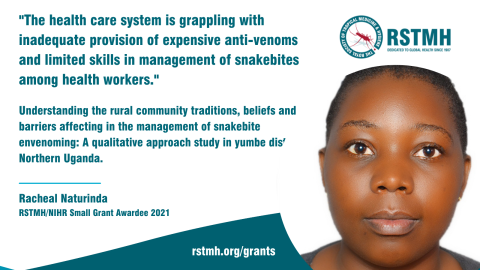
Research topic: Understanding the rural community traditions, beliefs and barriers affecting in the management of snakebite envenoming: A qualitative approach study in yumbe district Northern Uganda.
Why did you choose to do research in snakebite?
As early career researcher with great interest in generating evidence based knowledge in NTDs. I chose area of because there was arise country registering high cases of snakebite for-example Yumbe district was among width of the highest registered (395) cases of snakebites in 2019.
The health care system was also grappling with inadequate provision of expensive anti-venoms and limited skills in management of snakebites among health workers.
Communities mainly rely on traditional therapies as first line option for management of snake bite envenoming which are sometimes harmful, can lead to disability and sometimes death. In Uganda, specifically, there is limited information available on the burden and barriers to snakebite envenoming (HAI, 2019).
What Challenges and Barriers in Accessing Effective Snakebite Treatment have you seen?
Quotes from the research study:
- “Here, these small facilities like HCII do not have medicines for treating snake bites like anti-venom, forexample me when I was bitten by snake, I was first brought to this facility called locombgo HCII and since the required medicines were not there, I was transferred to bidibidi health Centre III, that’s why you see me a live today. if it was a big snake, then I would have passed away that time."
- “Transport is the biggest challenge we face, to bring someone to health centre faster is not available. It makes people to delay to seek health care and in the process of looking for transport, we give the raw eggs, potatoes and use 500= coin to suck the poison from spreading the body”.
- “We have limited number of service providers to attend to patients at night when they are sleeping”.
- “We have shortage of drugs for treatment and we are sometimes told to go to another facility”.
- “We also lack public awareness on snake bite and how to protect. We are not given such information like measles and other epidemic diseases. Otherwise the cases could reduce”.
- “The biggest challenge I must admit at health centre III with supplies, stock out. we usually recieve drug IV hydrocortisone and IV fluid, in a quarter we receive 1 box and the consumption is very high in maternity. In a month, we deliver about 60 to 70 mothers and you can imagine with 1 box and then you bring the case of snake, but also the community social economic factor is not okay when you tell someone snakebite medication is out of stock for ample we do not get supplies with anti-venom at our level”.
NIHR/RSTMH Small Grant awardee 2021
Katharina Kreppel
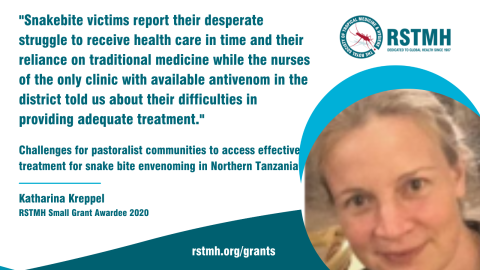
Research topic: Challenges for pastoralist communities to access effective treatment for snake bite envenoming in Northern Tanzania
What Challenges and Barriers in Accessing Effective Snakebite Treatment have you seen?
The burden of snakebite envenoming and its consequences in Tanzania is an under-researched area. The challenges faced by victims to receiving treatment are largely unknown as well as the challengesto providing treatment by health care professionals. In an attempt to explore the current situation and map a path towards change, we embarked on a pilot research project on “Risks of snakebite and challenges to seeking and providing treatment for agro-pastoral communities in Tanzania”. Snakebite victims report their desperate struggle to receive health care in time and their reliance on traditional medicine while the nurses of the only clinic with available antivenom in the district told us about their difficulties in providing adequate treatment.
We learnt that “it’s not just about arriving in time at a hospital – it’s much more complicated than that”. In order to investigate risks of snakebite and the challenges and barriers to treatment, we have to look at both sides – the treatment seeking and the treatment providing side.
Wellcome Trust/RSTMH Small Grant awardee 2020
Laban Mildred Nje
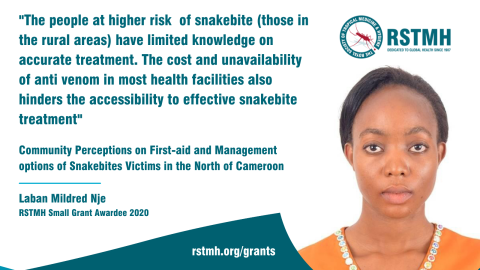
Research topic: Community Perceptions on First-aid and Management options of Snakebites Victims in the North of Cameroon
Why did you choose to do research in snakebite?
Snakebite is a Neglected Tropical disease which is causing a lot of deaths and amputations in my country. The population at higher risk (those in the rural areas) have limited knowledge on accurate treatment and are inaccessible to treatment.
What Challenges and Barriers in Accessing Effective Snakebite Treatment have you seen?
Many individuals in Cameroon have relied on their passed down first aid and methods of treating snakebite and as such face difficulties adapting to the medically accurate adopted first aid and treatment methods given to them.
Cost and unavailability of anti venom in most health facilities hinder accessibility to effective snakebite treatment
NIHR/RSTMH Small Grant awardee 2020
Dr Huda Khalid
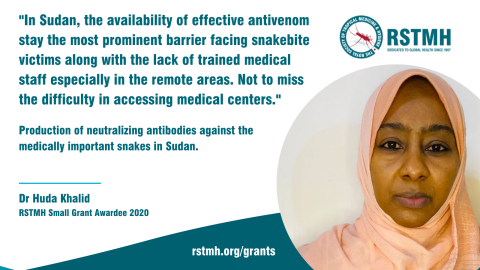
Research topic: Production of neutralizing antibodies against the medically important snakes in Sudan.
Why did you choose to do research in snakebite?
Working in the field of snakebite envenomation have been a great chance for me to help in resolving the problem in my home country in which snakebite research in very limited. Many farmers and children dead due to snakebite accidents in the agricultural fields while practicing manual planting and harvesting.
What Challenges and Barriers in Accessing Effective Snakebite Treatment have you seen?
In Sudan, the availability of effective antivenom stay the most prominent barrier facing snakebite victims along with the lack of trained medical staff especially in the remote areas. Not to miss the difficulty in accessing medical centers. Also, like many other African countries, most of the victims believe on traditional hailers and folk medicine.
Wellcome Trust/RSTMH Small Grant awardee 2020
Mawuli Leslie Aglanu
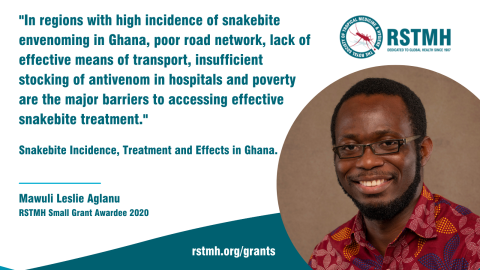
Research topic: Snakebite Incidence, Treatment and Effects in Ghana.
Why did you choose to do research in snakebite?
Aside the pernicious effects of snakebite envenoming, the long-term consequences of the bite to survivors have not been adequately assessed leaving many victim to suffer silently. In my chosen area of snakebite research, I aim to generate the evidence required to reform treatment practices and debunk noxious community practices and perception.
What Challenges and Barriers in Accessing Effective Snakebite Treatment have you seen?
In regions with high incidence of snakebite envenoming in Ghana, poor road network, lack of effective means of transport, insufficient stocking of antivenom in hospitals and poverty are the major barriers to accessing effective snakebite treatment.
NIHR/RSTMH Small Grant awardee 2020